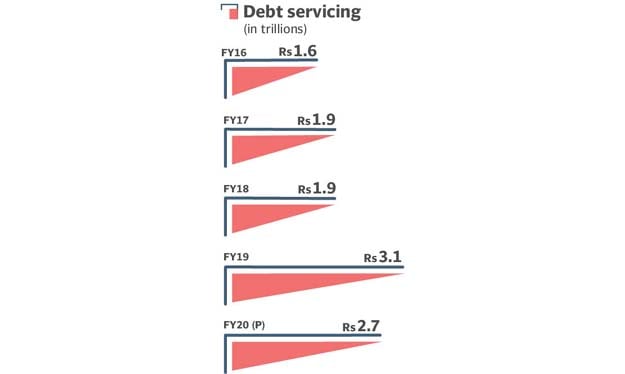Covid-19 shock may increase Pakistan's debt-to-GDP ratio
It will be mainly due to sharp decline in economic growth, increase in budget deficit
ISLAMABAD:
The total public debt of Pakistan increased 7.6% in first nine months of the current fiscal year compared to the same period of last year, reveals Pakistan Economic Survey 2019-20.
Total public debt was recorded at Rs35,207 billion at the end of March 2020 compared with Rs32,708 billion at the end of June 2019, registering an increase of Rs2,499 billion in first nine months of FY20. Federal government borrowing for financing its deficit came in at Rs2,080 billion during the nine-month period under review.
“This differential is mainly attributable to the depreciation of Pak rupee against the US dollar, increase in cash balances of the federal government and the difference between face value (which is used for recording of debt) and the realised value (which is recorded as budgetary receipt) of PIBs (Pakistan Investment Bonds) issued during the said period,” the survey said.
Of the total debt level, Rs22,478 billion comprised the domestic debt whereas Rs12,729 billion was the external debt. Contrary to last year, most of the net domestic debt raised during first nine months of the current fiscal year was through medium-to-long-term government securities (PIBs) and National Savings Schemes (NSS), said the survey.
Even within short-term floating debt, the government borrowed mostly via 12-month treasury bills (T-bills). Resultantly, the share of three-month bills in the total T-bills portfolio shrank to around 28% at the end of March 2020 compared with around 100% at the end of June 2019.
On the external front, all of the net external debt raised in first nine months of FY20 was from multilateral and bilateral sources. Accordingly, the share of multilateral and bilateral debt inched up in the external public debt portfolio while the share of debt obtained from commercial sources (loans from foreign commercial banks and Eurobonds) declined in Jul-Mar FY20 compared with the last fiscal year.
Total public debt-to-gross domestic product (GDP) ratio stood at 72.1% while total government debt-to-GDP ratio was 66.5% at the end of 2017-18. However, total public debt and total government debt as a percentage of GDP reached 86.1% and 77.7%, respectively at the end of June 2019, the survey said.

Apart from fiscal deficit, an unprecedented revaluation loss on account of currency depreciation and build-up of liquidity buffer contributed significantly to the increase in the debt-to-GDP ratio in fiscal year 2018-19. The debt-to-GDP ratio was expected to decline at the end of 2019-20 on the back of fiscal consolidation efforts of the government. However, the Covid-19 shock is expected to result in a higher-than-anticipated debt-to-GDP ratio mainly due to a sharp decline in growth and increase in budget deficit.
Interest servicing was recorded at Rs1,880 billion in first nine months of the current fiscal year against the annual budgeted estimate of Rs2,891 billion. Domestic interest payments were recorded at Rs1,646 billion, constituting 88% of total interest servicing in Jul-Mar FY20, which was attributed to a higher volume of domestic debt in the total public debt portfolio.
Domestic, external debt
Domestic debt is primarily obtained to finance fiscal deficit while also lending support to the Public Sector Development Programme (PSDP).
Domestic debt reached Rs22,478 billion at the end of March 2020. Domestic borrowing operations remained quite successful during the ongoing fiscal year despite a challenging macroeconomic situation, the survey said.
Pakistan’s external debt and liabilities (EDL) represent the debt and liabilities of public as well as private sectors. The part of EDL that falls within the government domain is the debt which is serviced out of the consolidated fund and owed to the International Monetary Fund (IMF).
The remaining includes liabilities of the central bank, debt of public sector entities, private sector and banks. EDL reached $110 billion by the end of March 2020, registering an increase of $3.6 billion in first nine months of FY20.
A main component of the increase was the external public debt stock that rose $3 billion. It revealed that the debt from multilateral and bilateral sources increased $2.3 billion. However, these loans were mostly contracted on concessional terms (low cost and longer tenor), the survey said. The stock of commercial loans/Eurobonds decreased $0.7 billion whereas non-resident investment in government securities was recorded at $1.4 billion.
“It is important to highlight that the government of Pakistan does not have any currency exposure on these securities as these are denominated in Pak rupee,” said the survey. The SBP’s foreign exchange liabilities decreased $0.6 billion mainly due to the repayment of Qatar deposit and the debt of public sector enterprises (PSEs) dropped $0.5 billion.
“External borrowing by the private sector is a healthy sign, indicating the private sector’s capacity to borrow for local investment. Private sector debt and liabilities increased $1.7 billion,” the survey said.
External loans
Gross external loan disbursements were recorded at $8,017 million in the first nine months of FY20.
Disbursements from multilateral sources including the IMF amounted to $4,839 million, accounting for 60% of total disbursements, in which the Asian Development Bank (ADB) and the IMF were the main contributors. Disbursements from the IMF were part of the ongoing Extended Fund Facility (EFF) while inflows from the ADB and other international financial institutions were largely targeted towards energy, finance and infrastructure development.
Disbursements from bilateral sources stood at $1,305 million. Out of this, disbursements from Saudi Arabia and China were $720 million and $460 million respectively. Commercial loans contributed $1,873 million to the external public debt disbursements. These loans were primarily obtained for the balance of payments support.
In the wake of the Covid-19 outbreak, Pakistan has secured $1,386 million under the IMF’s Rapid Financing Instrument (RFI) facility in order to counter the negative impact of the pandemic on the economy by increasing social sector spending.
Further Covid-based external inflows are expected from the World Bank and ADB in fourth quarter of the current fiscal year. External public debt repayments were recorded at $5,537 million in first nine months of FY20 compared with $4,138 million in the same period of last year.
The repayment of Eurobonds amounting to $1,000 million and higher repayments to the IMF mainly contributed to the increase in repayments. Interest payments stood at $1,579 million in Jul-Mar FY20.
Published in The Express Tribune, June 12th, 2020.
Like Business on Facebook, follow @TribuneBiz on Twitter to stay informed and join in the conversation.


COMMENTS
Comments are moderated and generally will be posted if they are on-topic and not abusive.
For more information, please see our Comments FAQ